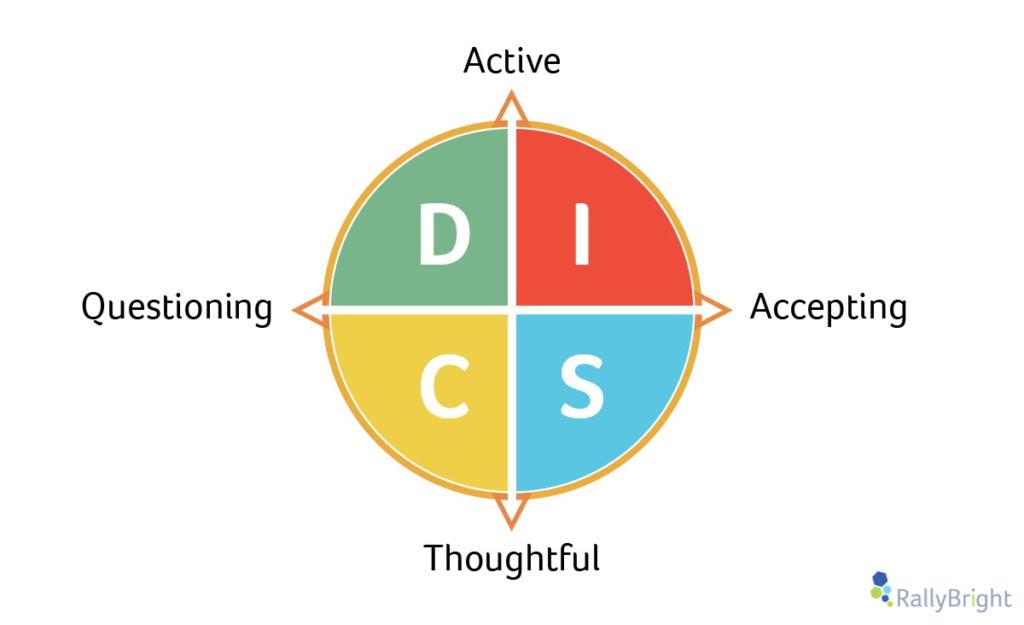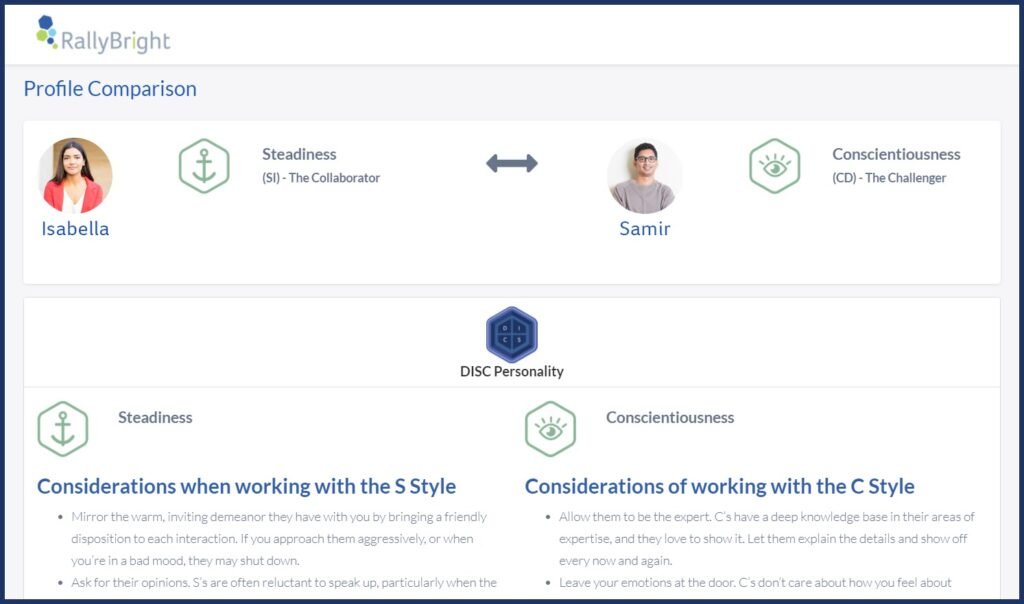Do you sometimes find yourself thinking of a coworker, “How could they do that?” Whether in frustration or admiration, your reaction reflects our widespread fascination with individual differences. Our desire to better understand each other is now supported by a roughly $500 million personality testing industry. These personality assessments are used by many companies, including household names Facebook, Google and Amtrak, with results influencing everyday interactions as well as important decisions with lasting impact.
One of the most popular personality tests in the world is the DISC assessment. Thousands of companies use this assessment every year. So what is DISC and how can it make a difference to your team?
DISC Theory
Psychologist William Marston’s research explored how our emotions lead to differences in our behavior. In the 1920s, Marston proposed the DISC theory ─ that emotional expression can be categorized into Dominance (D), Inducement (I), Submission (S) and Compliance (C) behavioral types. Today, most DISC assessments use updated words for these categories. Our own model here at RallyBright, for instance, uses Dominance, Influence, Steadiness and Conscientiousness.
You likely see aspects of yourself in all of these categories, yet the DISC model suggests that individuals draw on one more than the others. A DISC assessment can help you identify which of the four behavioral types is your primary style, facilitating a greater understanding of how you approach situations and how that may differ from other people. You might consider this primary style your comfort zone, a space that certain situations may require you to stretch beyond.

Using DISC to Work Better Together
Becoming more aware of how you and your teammates tend to behave and respond may help you better manage the relationships that can determine whether your team achieves its goals.
For example, RallyBright founder John Estafanous brings an awareness of his D style – and the ways it differs from the styles of his teammates – to his work communications. He might soften his skepticism with idealistic I’s or bring more warmth to interactions with harmony-seeking S’s.
By understanding and leveraging these nuances, you may interact with others more skillfully. DISC can support conflict management, teamwork, leadership and other important facets of an organization.

The DISC Styles
The four DISC styles are the result of two overlapping dimensions. Wiley frames the vertical dimension as ranging from active to thoughtful while the horizontal dimension ranges from questioning to accepting. These basic aspects of human nature form the multifaceted DISC quadrants. DISC assessments may further divide these quadrants into more specific types.
Now, let’s dig into what characterizes each of the four DISC styles.
Dominance: D-style team members are results-driven, direct and determined. They value action and taking on challenges. This competitive style is motivated by winning and success. Competency and personal freedom are very important to D’s. In meetings, D styles prefer sticking to an agenda and minimizing small talk.
To improve your communication with D-style team members, be direct and focus more on the desired outcome than the problem. D’s themselves may need to be more intentional about showing patience and sensitivity as well as giving more detailed explanations.
Influence: Building relationships is very important to I’s and these individuals influence others with their energy and optimism. I styles are outgoing and prioritize taking action. Often seen as warm, collaborative, optimistic and enthusiastic, I’s value freedom of expression as well as coaching and counseling.
In meetings, I styles thrive when allowed to express their own opinions and may be more talkative than other team members. A good strategy is to listen and allow them to ask questions, keeping your communication positive. I’s themselves might find it challenging to be organized and communicate directly.
Steadiness: Your gentle, patient, deliberate and consistent teammate may be an S style. S’s prioritize supporting others and collaborating. They value security and want a stable, harmonious environment. Thoughtful and thorough S’s can be challenged by change or multitasking and may find themselves being pushed to act more decisively. S’s may need to promote themselves and their ideas, particularly if a D manager does not value their approach.
How can you work better with your S colleagues? You might offer S’s an outline before a meeting and ensure that everyone in the meeting has an opportunity to be heard. Kindly set clear expectations with your S teammates and show that you are interested in them.
Conscientiousness: Precise, analytical and diplomatic C’s prioritize accuracy and stability. They highly value competency and strive for excellent quality in their work. That said, progress can sometimes be hindered by their tendencies to both overanalyze and to isolate themselves. Making quick decisions and delegating tasks can also be challenging for C’s.
In meetings, avoid pressuring C’s to make big decisions right away. They may need more time to assess all of the details before drawing conclusions. When communicating with C’s, be sure to know your details and understand that they may not respond well to strong displays of emotion. C-style individuals should also be aware that their approach may seem efficient yet impersonal to others. I’s and S’s might appreciate more emotional expressiveness from their C teammates.
Personality Assessment Pitfalls
While DISC and other personality assessments can be used to gain insight into people’s tendencies, misunderstanding or misusing them could be harmful.
We can use personality types to better understand ourselves and others, but it’s best to avoid viewing these styles as strict divisions that define us. You may see several different styles in yourself and others. It’s still not clear whether a person’s personality stays consistent and can be measured. Research suggests that our personality actually changes at certain important times in our lives, such as when we start working. Some features of our behavior are more stable than others.
The seemingly clear-cut results of personality tests can be tempting to use in ways that turn out to be harmful. It’s best to avoid forming expectations about an employee’s success based on their personality test results. These results don’t predict an employee’s performance in a particular position and using them for this purpose can be very limiting for both people and organizations.
From Understanding to Action
Many of us are exceptionally busy and overloaded with information on a daily basis. Even the most fascinating and useful knowledge is at risk of being forgotten or never applied in our work. In fact, this is the case for an estimated 40 to 85 percent of all training. So how do we keep our DISC insights from getting lost in the “Knowing-Doing Gap”?
Kevin Kruse, CEO of LEADx, explains that communicating your DISC type with a sticker, desk placard, slack handle or email footer may serve as a reminder to apply knowledge of DISC styles. He also suggests that behavioral nudges can make a huge difference. Kruse describes a nudge as “an indirect suggestion or subtle reminder intended to influence people’s behavior.” The term was defined and popularized by economics professors Richard Thaler and Cass Sunstein.
Nudges can be delivered in a variety of ways, Kruse says, such as placing objects in a particular position or posting a sign. However, you can now harness technology to amplify your efforts with digital messages. Employees may periodically receive a notification reminding them of an insight about their own or a coworker’s DISC style. You might consider the ways your team can use nudges or other methods to help integrate their understanding of DISC into everyday work situations. Additionally, if you and your teammates use the RallyBright platform, you can each share your DISC style with one another and then get interaction-related tips for each teammate, based on their DISC style.

The DISC Profile Comparison in the RallyBright Platform
As BBC’s Bryan Lufkin points out, personality tests can be a fun way to spark conversation among teammates and “serve as a reminder that not everyone sees the world the same way.” Using the DISC model to become more aware of our similarities and differences may help us honor and appreciate the diversity within our teams. Bringing this awareness to our relationships can be crucial to our team’s success.


